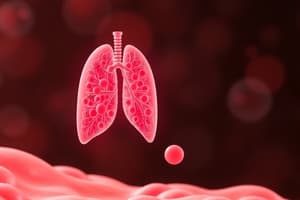Podcast
Questions and Answers
Glycolysis is a metabolic pathway that breaks down glucose into ATP.
Glycolysis is a metabolic pathway that breaks down glucose into ATP.
False (B)
Glycolysis occurs in the nucleus of eukaryotic cells.
Glycolysis occurs in the nucleus of eukaryotic cells.
False (B)
Stage One of glycolysis involves the conversion of glucose to fructose 6-phosphate by hexokinase.
Stage One of glycolysis involves the conversion of glucose to fructose 6-phosphate by hexokinase.
True (A)
Fructose 6-phosphate is cleaved into two molecules of glucose in Stage Two of glycolysis.
Fructose 6-phosphate is cleaved into two molecules of glucose in Stage Two of glycolysis.
The primary end product of glycolysis is ATP.
The primary end product of glycolysis is ATP.
Under anaerobic conditions, pyruvate enters the mitochondria for further metabolism.
Under anaerobic conditions, pyruvate enters the mitochondria for further metabolism.
Lactate fermentation and ethanol fermentation are examples of alternative metabolic pathways under anaerobic conditions.
Lactate fermentation and ethanol fermentation are examples of alternative metabolic pathways under anaerobic conditions.
Glycolysis typically produces ATP through electron transport chains during aerobic respiration.
Glycolysis typically produces ATP through electron transport chains during aerobic respiration.
In lactate fermentation, NADH from glycolysis reduces pyruvate to form lactic acid.
In lactate fermentation, NADH from glycolysis reduces pyruvate to form lactic acid.
Ethanol fermentation involves converting pyruvate into acetic acid and CO2.
Ethanol fermentation involves converting pyruvate into acetic acid and CO2.
Fermentation is a process that cells use to generate energy under aerobic conditions.
Fermentation is a process that cells use to generate energy under aerobic conditions.
Butyric acid fermentation produces ATP from NADH via electron transport chains.
Butyric acid fermentation produces ATP from NADH via electron transport chains.
Flashcards are hidden until you start studying
Study Notes
Glycolysis Process
Glycolysis is a fundamental metabolic pathway responsible for generating energy through the breakdown of glucose into pyruvate. This process occurs in the cytoplasm of cells within eukaryotes and bacteria. It consists of two primary stages: glyceraldehyde-3-phosphate oxidation and substrate level phosphorylation.
Stage One: Glyceraldehyde-3-Phosphate Oxidation
The initial step involves the conversion of glucose to fructose 6-phosphate by hexokinase, which requires ATP consumption. In this stage, some of the glucose molecules are converted to 6-phosphofructose via the enzyme glyceraldehyde 3-phosphate dehydrogenase.
Stage Two: Substrate Level Phosphorylation
In this phase, fructose 6-phosphate is cleaved by aldolase into two molecules of dihydroxyacetone phosphate. These intermediates undergo further reactions catalyzed by triose phosphate isomerase and aldolase to eventually produce three molecules of glyceraldehyde 3-phosphate.
Products of Glycolysis
The primary end product of glycolysis is pyruvate, which can be further metabolized depending on whether aerobic or anaerobic conditions exist. Under aerobic conditions, pyruvate enters the mitochondria to participate in additional cellular processes, such as the Krebs cycle and electron transport chain, leading to more efficient ATP generation.
Under anaerobic conditions, pyruvate may be subjected to several alternative metabolic pathways known as fermentation, including lactate fermentation, ethanol fermentation, and other less common routes involving different terminal electron acceptors.
Anaerobic Respiration & Energy Production
While glycolysis typically produces ATP indirectly through its downstream utilization during aerobic respiration, some organisms like yeast and muscle cells employ anaerobic respiratory mechanisms when oxygen is unavailable or limited. These alternate pathways generate ATP through substrate-level phosphorylation rather than relying on electron transport chains.
Lactate fermentation is one example where NADH from the glycolytic pathway reduces pyruvate to form lactate, concurrently generating ATP through substrate-level phosphorylation. Another anaerobic respiratory pathway, ethanol fermentation, converts pyruvate into ethanol and CO2, producing ATP from NADH.
Fermentation
Fermentation is a process by which cells generate ATP under anaerobic conditions by metabolizing pyruvate or other molecules. This anaerobic respiration is essential for some organisms' survival in oxygen-limited environments. Some common fermentation processes include:
- Lactic acid fermentation: In this process, pyruvate is reduced to lactic acid, and ATP is generated via substrate-level phosphorylation.
- Ethanol fermentation: This anaerobic respiration involves the conversion of pyruvate to ethanol and CO2, generating ATP through substrate-level phosphorylation.
- Butyric acid fermentation: This process converts pyruvate into butyric acid, producing ATP from NADH via substrate-level phosphorylation.
In summary, glycolysis is a critical metabolic pathway responsible for generating energy through the breakdown of glucose into pyruvate. Its products play a crucial role in various cellular processes, including energy production under aerobic conditions and alternative anaerobic respiratory mechanisms such as fermentation.
Studying That Suits You
Use AI to generate personalized quizzes and flashcards to suit your learning preferences.





